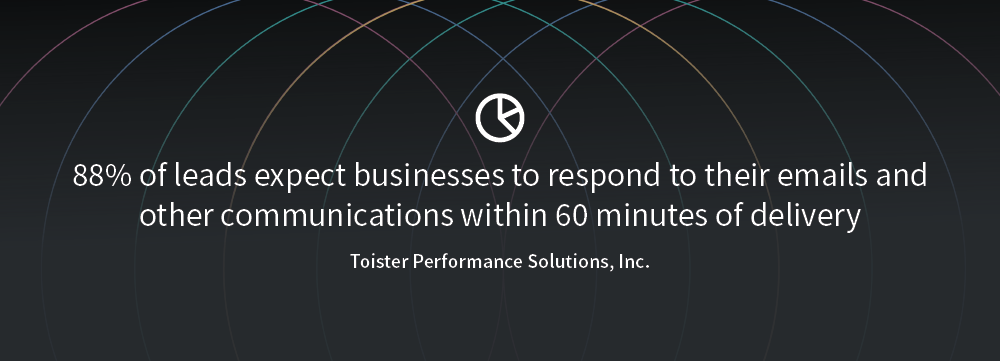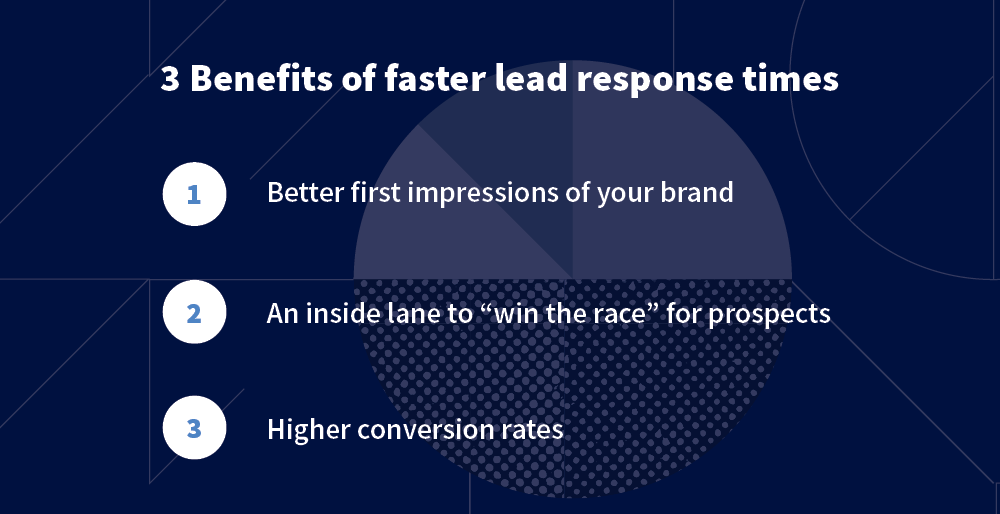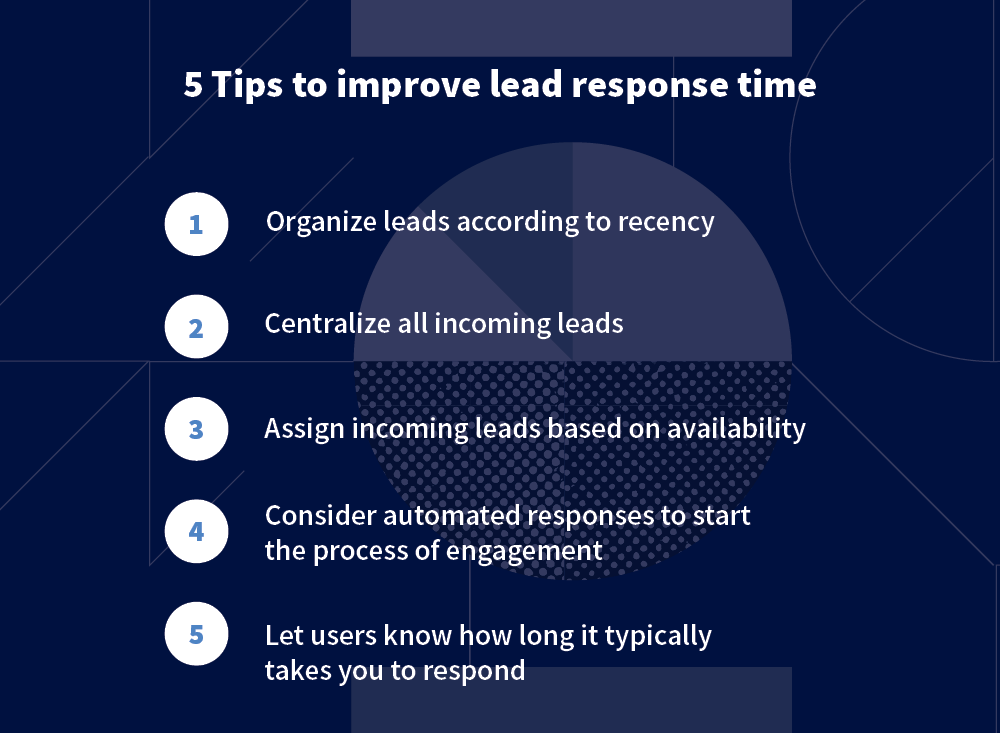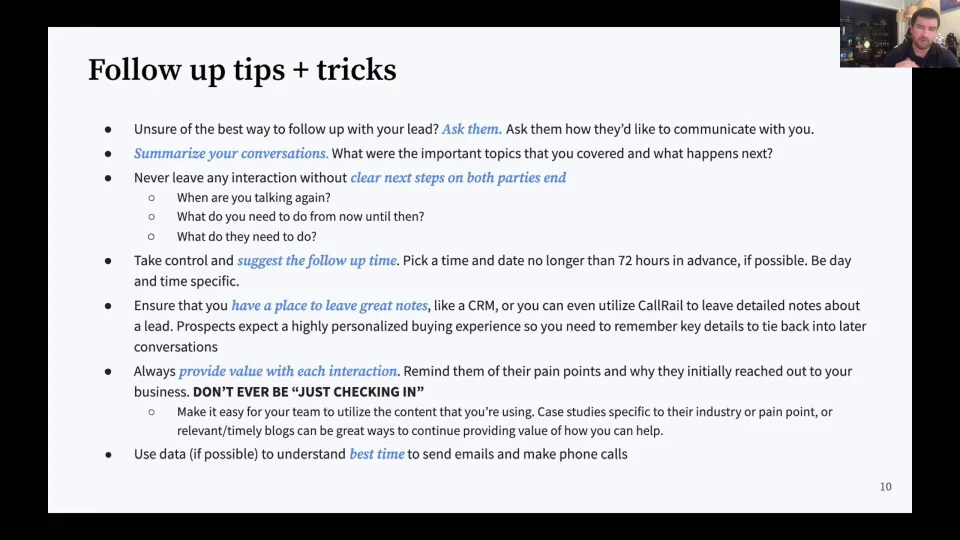TL;DR:
- Surveys have shown that 88% of leads expect businesses to respond to their emails and other communications within 60 minutes of delivery.
- Sales teams should challenge themselves to respond to leads within minutes of receipt to start the customer relationship off on solid footing and to beat competing sales teams to the punch.
- To support sales teams in organizing and optimizing their lead response efforts, provide lead tracking software and other tools to streamline their sales process.
When your company receives a new lead, time is of the essence. Leads are notoriously impatient people: Surveys have shown that 88% of leads expect businesses to respond to their emails and other communications within 60 minutes of delivery.
A full 30% of leads say they want a response within 15 minutes. Yet we know from other surveys that most businesses fall short of this mark: Only 37% of leads receive a response within the first hour. Twenty-four percent of those businesses take more than 24 hours to respond — and 23% don’t respond at all.
In today’s fast-moving business environment, a fast response can make all the difference. Sales teams should challenge themselves to respond to leads within minutes of receipt to start the customer relationship off on solid footing and to beat competing sales teams to the punch.
To meet these tall demands, efficiency and organization are required. And quite often, technology is the answer to achieving this level of performance. Here’s a deeper look at the importance of lead response times and how to turn this aspect of sales performance into an organizational strength.
The importance of improving your lead response time
How you start your relationships with leads plays a significant role in determining the outcome of those relationships — namely, whether leads convert into customers.
A faster lead response time has implications on the following aspects of your sales team’s performance:
- Better first impressions of your brand. Your first interaction with a prospect can have a significant impact on the potential value of that relationship. Regardless of the lead’s prior knowledge of your business, your response time reflects how much you value that potential relationship. Leads will use the speed and quality of your response to evaluate the kind of customer experience they can expect with your brand. A strong first impression gives your sales team a chance to build conversion momentum right out of the gate.
- An inside lane to “win the race” for prospects. Many leads solicit multiple companies at once. The first brand to respond to those leads takes an early advantage by seizing the opportunity to move the lead down the sales funnel.
- Higher conversion rates. Responses that come in less than five minutes are 21 times more likely to help qualify leads than slower responses. When you’ve got a solid sales engagement strategy backing your first response, the math in support of a quick response time is hard to deny. Speed matters to your customer base — and the value of that metric is reflected in your sales ROI.
When you’re planning out how to improve your response times, though, your sales team’s bandwidth must be taken into account. If lead generation efforts are bringing waves of new responses into your inbox, your sales team will likely become overwhelmed and unable to keep pace. This results in diminishing returns for your lead-gen efforts.
Tips for improving your sales team’s response time
The first step to improving your lead response time is recognizing the importance of providing a faster response. But consistent response times can be achieved only when you have the right infrastructure to support new sales team priorities.
Here are some tips for organizing and streamlining your sales team’s lead response strategy:
- Organize leads according to recency. By organizing leads in the order they first contacted your business, your sales reps can actively monitor the age of these leads and prioritize which leads to grab first. If your sales team is consistently meeting its response time goals, you might encourage them to grab the oldest lead available. But if your sales team is struggling to keep up, it might make more sense to always grab the newest lead, rather than starting with older leads and trying to catch up.
- Centralize all incoming leads. Lost or mismanaged leads are wasted sales opportunities for your business. Calls and forms should be consolidated so that leads don’t go missing. Make it easy for your sales pros to find leads in need of a response.
- Assign incoming leads based on availability. An even distribution of leads across your sales team is a setup for failure. Inevitably, one of your team members will be overwhelmed with work, out of the office, or tied up and unable to respond to their assigned leads within the target time frame. When that happens, the value of those assigned leads will plummet. Instead, assign new leads to whoever can respond fastest, or encourage your sales team to collaborate on dividing up tasks as they come up.
- Consider automated responses to start the process of engagement. Automated emails, chatbots, and other tools can provide a fast, instant response that engages the prospect right away — and gives your sales pros time to catch up if they’re inundated with work.
- Let users know how long it typically takes you to respond. It won’t always be possible to respond right away — so inform them of your operating hours and expected time frame for a response. If you beat that window, it makes you look good. Just be sure not to miss this window, or it could upset prospects.
Using technology to improve your lead response time
Tracking inbound leads is difficult and tedious — especially when you’re tracking multiple points of interaction across all stages of the sales funnel. Lead responses also exist among many other sales responsibilities: Many small and midsize businesses, for example, must balance the needs and requests of current customers while also handling new leads.
To support sales teams in organizing and optimizing their lead response efforts, businesses should invest in solutions that help sales professionals do their jobs more efficiently.
Wondering which sales tools can enable a faster lead response? Here are three that will make an immediate impact at your business:
- Call Tracking: A call tracking solution doesn’t just log the inbound calls from potential leads. Through dynamic number insertion (DNI) and other tracking tools, this software also tells you the referral source for those calls, which can help you engage prospects with relevant messaging from the first interaction.
- Form Tracking: CallRail’s Call Tracking software also supports tracking for online forms. When users fill out an online form — which can range from general inquiries to forms filled out in exchange for gated content — their contact information is immediately displayed in your tracking log, giving you the essential data you need to provide a prompt response.
- Lead Center: CallRail’s Lead Center is an easy-to-use, unified business communications solution that lets you manage conversations and contacts, communicate via your customer's preferred channels, and analyze conversations to optimize customer experience and drive ROI.
Combined with your CRM and other sales tools, these solutions will ensure no lead gets lost. They’ll give your team the ability to prioritize responses, coordinate interactions, and collaboratively manage lead responses to secure better results than ever before.
Don’t take new leads for granted
When you’ve found success in generating leads, it’s easy to rest on your laurels and convince yourself you’ve built a strong top-of-funnel sales strategy. But if your lead response strategy isn’t focused on connecting with leads as quickly as possible, you’re leaving customers — and revenue — on the table.












%22%2C%22Id%22%3A%2232%22%7D%2C%22Var%22%3A%7B%22Name%22%3A%22Website%22%2C%22Id%22%3A%221%22%7D%2C%22U%22%3A%22D5C2BE3D78800A6948B48C9EF83ED3EC2%22%7D%2C%7B%22Exp%22%3A%7B%22Name%22%3A%22Clicks%20start%20free%20trial%20(home%20page)%22%2C%22Id%22%3A%2233%22%7D%2C%22Var%22%3A%7B%22Name%22%3A%22Website%22%2C%22Id%22%3A%221%22%7D%2C%22U%22%3A%22D5C2BE3D78800A6948B48C9EF83ED3EC2%22%7D%2C%7B%22Exp%22%3A%7B%22Name%22%3A%22Signups%22%2C%22Id%22%3A%2242%22%7D%2C%22Var%22%3A%7B%22Name%22%3A%22Website%22%2C%22Id%22%3A%221%22%7D%2C%22U%22%3A%22D5C2BE3D78800A6948B48C9EF83ED3EC2%22%7D%2C%7B%22Exp%22%3A%7B%22Name%22%3A%22Homepage%20Trial%20Clicks%22%2C%22Id%22%3A%2284%22%7D%2C%22Var%22%3A%7B%22Name%22%3A%22Website%22%2C%22Id%22%3A%221%22%7D%2C%22U%22%3A%22D5C2BE3D78800A6948B48C9EF83ED3EC2%22%7D%2C%7B%22Exp%22%3A%7B%22Name%22%3A%22Sitewide%20Trial%20Clicks%22%2C%22Id%22%3A%2285%22%7D%2C%22Var%22%3A%7B%22Name%22%3A%22Website%22%2C%22Id%22%3A%221%22%7D%2C%22U%22%3A%22D5C2BE3D78800A6948B48C9EF83ED3EC2%22%7D%2C%7B%22Exp%22%3A%7B%22Name%22%3A%22Pricing%20Trial%20Clicks%22%2C%22Id%22%3A%2286%22%7D%2C%22Var%22%3A%7B%22Name%22%3A%22Website%22%2C%22Id%22%3A%221%22%7D%2C%22U%22%3A%22D5C2BE3D78800A6948B48C9EF83ED3EC2%22%7D%5D%7D&_biz_u=9a0d921213b345b4ec64800127638c3f&_biz_l=https%3A%2F%2Fwww.callrail.com%2Fblog%2Fhow-to-improve-lead-response-time&_biz_t=1744150265352&_biz_i=How%20to%20improve%20your%20lead%20response%20time%20&_biz_n=1&rnd=54633&cdn_o=a&_biz_z=1744150265352)
